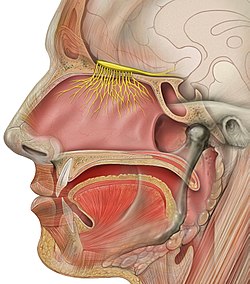| Cerebrospinal fluid rhinorrhoea | |
|---|---|
| Specialty | Neurology, neurosurgery, otorhinolaryngology,Oral and maxillofacial surgery |
| Symptoms | clear, colourless liquid draining from nose |
| Complications | infection |
| Causes | basilar skull fracture |
| Diagnostic method | brain scans, testing nasal discharge to see if it is CSF |
| Differential diagnosis | other types of rhinorrhoea |
| Treatment | conservative management: observation neurosurgery: repairing any skull fracture |

Cerebrospinal fluid rhinorrhoea (CSF rhinorrhoea) refers to the drainage of cerebrospinal fluid through the nose (rhinorrhoea). It is typically caused by a basilar skull fracture, which presents complications such as infection. It may be diagnosed using brain scans (prompted based on initial symptoms), and by testing to see if discharge from the nose is cerebrospinal fluid. Treatment may be conservative (as many cases resolve spontaneously), but usually involves neurosurgery.